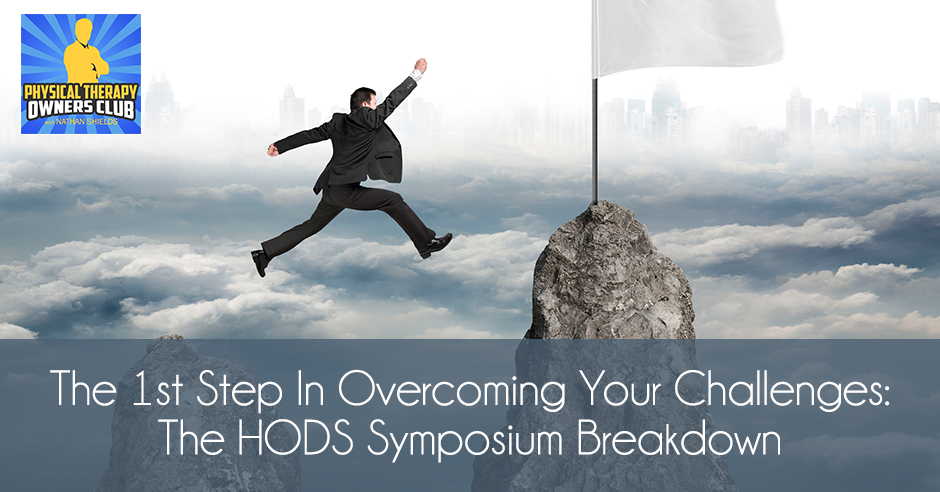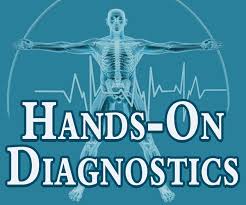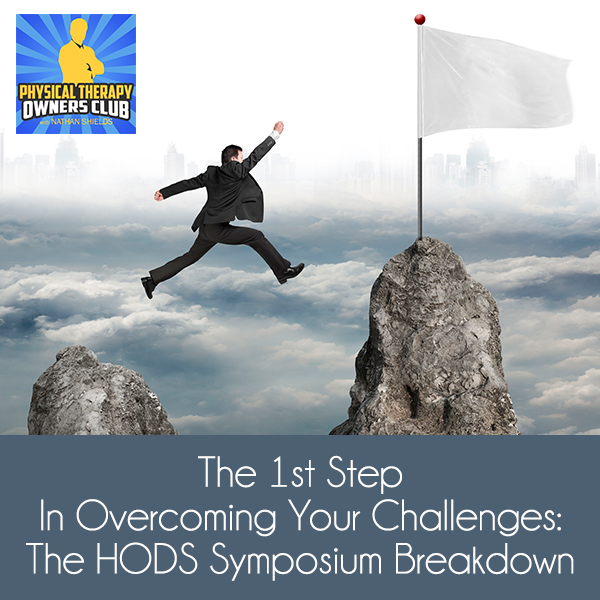
—
Listen to the podcast here:
The 1st Step In Overcoming Your Challenges: The HODS Symposium Breakdown
I’m going to do something a little bit different. I don’t have a guest to interview like I usually do on the podcast, but I went to the HODS Symposium in New York. I thought, “Why don’t I take down some notes and share with the audience a little bit about what I learned from the different speakers? Share that with you in case you weren’t able to get there.” I thought maybe I’ll do that with this. I’ll also do that with PPS coming up in November. I’ll be going out to a CSM in DC. That’s in January or February 2019. As I go to these different events, I can take some notes and share with you what I learned. That way you can get a little bit of what’s going on in the industry or at some of the events that you’re not able to attend.

The HODS symposium, this was the fifth annual one and HODS stands for Hands On Diagnostic Services. It was led out by the Cofounder and CEO Dimitrios Kostopoulos. I’ve interviewed him on a prior podcast episode and so you can check him out. If you haven’t seen any of his advertising, he’s big into electrodiagnostic, specifically EMGs and diagnostic ultrasound and incorporating that into physical therapy practices making it a larger scope within our practice to make physical therapists more of the gatekeeper by simply being able to do some of these diagnostic tests within our practice and thus, improving our physical therapy.
As I went to the symposium, what I noticed, and I’m sure you noticed the same thing as you’ve gone to some of these conferences, is there are a bunch of owners out there that are continuing to grow and overcome adversity. In the first part of the HODS Symposium, Dimi shared with the owners specifically that’s exactly what life is all about. Essentially, life is all about overcoming adversity because we will always have challenges. In fact, one of his quotes was, “Part of life survival is simply overcoming problems that arise. Our capacity to survive and thrive is dependent upon our determination to survive.” What I got from that as I’ve looked at my own life’s purpose in recent years is that if I’m not overcoming issues, if I’m not achieving the goals that I want to achieve either personally or professionally, then the question to myself is, is my purpose strong enough? If I’m not working out as much as I like, if I’m not seeing the revenues that I want to see, what’s the end goal? What’s my purpose? I’d asked you the same thing. If you’re not achieving the goals that you want to achieve, if you’re not overcoming issues that you want to overcome, what’s your purpose? For what reason?
If you're simply a business owner and you think you own a company but instead you simply own a job, that's not a business owner. Click To TweetEither your purpose isn’t strong enough and maybe it needs to be readjusted. Maybe it needs to be reworded. Maybe it needs to be readdressed altogether, but simply if you’re not overcoming those issues, then you’re probably not dedicated to the purpose that you’ve got either established or semi-established in your brain. If you aren’t clear on the purpose and dedicated to it, that’s okay. Just recognize that and move on, readdress it, reword it, find a different purpose, whatever it might be. You can start overcoming those issues and challenges. As Dimi said, “You’ve got to recognize that the challenges are part of survival in this life. We’re all going to have challenges.” He asked an even better question that also pertains to purpose and that is he said, “How many of you in this room are business owners?” All of us raised our hands.
He turned us on our heads because he referenced Robert Kiyosaki’s book, Rich Dad, Poor Dad. If you’ve read Robert Kiyosaki’s book, he references what’s called the Cashflow Quadrant. Look at the quadrant, there are four boxes and on the top left quadrant is the letter E, in the bottom left quadrant is the letter S, in the top left quadrant is the letter B, and then in the bottom right quadrant is the letter I. Each of these stands for something. E stands for employee, S stands for self-employed, B stands for business owner and I stands for investor. Let’s define what each of those means. Employee simply is that you own a job, you trade your time and your efforts for money and you start over every day and you get a salary. That’s an employee. S stands for the self-employed. Not a whole lot different from employee. In some respects, it is but you’re trading your time and your efforts for money and you start over the next day. You have greater responsibilities and if you’re doing it right. You make a little bit more money than the employee as the business improves.
B stands for a business owner. A business owner has income that is not dependent upon their physical presence. They lead out on the business. They have the vision, the goals, they established culture and strategy, established regulatory and compliance standards, you name it. The business owner has income that is not dependent upon his physical presence and performing the work involved in that business. He’s not a producer per se. I, which is the goal of most business owners, is the investor. The investor simply provides the money, smart investments and watches it, encourages it and maybe even guides it on occasion to grow, but otherwise does not spend any time within the business at all.
Where are you on that quadrant? You might be a business owner. If you are a business owner, are you owning the job and thus simply self-employed or do you own a business that is not dependent upon your physical presence and production? Wherever you are on that quadrant is fine, as long as you recognize where you’re at and that’s where you want to be or at least you know where you’re going somewhere on that quadrant. If you’re simply a business owner and you think you own a company, but instead you simply own a job, that’s not a business owner. I personally had to check myself on that. Whenever you land in the E and the S quadrant on the left side, you’re limiting your business. We all need to recognize that. If you’re an employee or you’re self-employed and you’re not a business owner, your business will be limited and so will your income. If you’re looking for more, you need to move to the other quadrants to be a business owner or simply an investor. I got a lot out of his talk and that led into Christopher Music.
You can do some of those things yourself, but you can also delegate those. Click To TweetChristopher Music is another person who I’ve interviewed for the podcast previously and you should listen to his episode as well with me. He is a financial adviser and he’s advised hundreds of physical therapy owners and private practitioners in different fields as well. He lays out what the ideal scenario is for every private practice owner. This is how he lays it out. You can add to it if you like but he simply says this, “You have enough money to fund your lifestyle and not outlive the money. Enough money to fund retirement, established a private practice, prepared to sell in 90 days at 10% of current market value. No personal debts and all assets are protected and sudden swings in the market will not significantly affect you.” That’s the ideal scenario of any private practitioner according to Christopher Music.
How do you achieve those? You’ve got two hats as a business owner. You wear two hats. You might wear more actually, but your main two are the executive hat and the owner hat. The executive hat, you can delegate this and a lot of you guys have this in the form of an office manager. They may run the front office mostly. Maybe they oversee billing and some of your expenses and maybe do some bookkeeping, whatever you have them do. Nonetheless, you delegate a lot of those responsibilities to them and they are your executive unless you have an executive team. The executive hat consists of organizing and carrying out the intentions of the owner, establishing policy and procedures for all the staff, training all the staff on those standard management systems, those policies and procedures, being responsible for gross incomes and profits that are greater than 10%. If you’re not making at least 10% as a business owner, then you’ve got to question whether or not you’re in business for much longer or you need to do whatever it takes to improve your net profits.

The executive is also responsible for marketing, promotion and referrals and strategic planning for expansion. You can do some of those things yourself but you can also delegate those. There are some things that you cannot delegate and this is the owner’s hat and this is what you’re ultimately responsible for. I say you’re responsible for them but that doesn’t mean that you have to do them. Ownership of the responsibility is not doership, but it ultimately comes down to you that these things are accomplished. Number one, each owner needs to establish mission, vision and goals for the company. They need to establish standards and culture. They also need to establish legal and regulatory compliance, or at least they are responsible for the legal and regulatory compliance of the office. It all comes down to them. The buck stops there. It is their responsibility to create maximum value in their business. They act as the professional adviser for executives and team members. They also wisely use financial planning to meet the objectives of, not only the business but more importantly their household. The business funds their household.
Christopher Music has a great insight into that. I didn’t know he has videos and webinars and talks about it on our episode that the business isn’t the end game. Your personal household is the end game. If your household is not making it because the business isn’t making it, you’ve got to work on the business a lot so you can improve the household situation. That’s ultimately why you’re in business. Going back to purpose, it’s probably one of the purposes behind business ownership for you. Christopher had tons of great stuff to share.
The opioid epidemic has a solution and that could and should be focused on physical therapy. Click To TweetOne thing I wanted to hit on was some of the cool things that Hands On Diagnostic Services is doing. They announced at the Symposium two things in particular. You’ve got to understand that HODS has unparalleled support in the area of diagnostics when you sign up with them. They’ve established, in conjunction with the APTA and the American Academy of Clinical Electrophysiologist, a residency in EMG. What that means is that you don’t have to be on your own anymore to get an EMG board certification. You can go through the residency program in HODS and see fewer tests and have direct mentorship that allows you to sit for the board certification at any time. Secondly, they are also providing a fellowship in musculoskeletal ultrasound. Both of these things do not exist in the physical therapy profession at this time, they only exist within HODS.
There’s a residency program for EMG, underneath that, there is also a fellowship program for EMG. There’s also now a Fellowship for Musculoskeletal Ultrasound, which will eventually get you as a certified practitioner in musculoskeletal ultrasound. Both the residency in EMG and the fellowship in MSKUS will allow you to sit for the board exams, become certified and then be recognized by Medicare as certified providers and get full reimbursement for those tests. Great announcements, huge steps in the direction of electrodiagnostics field focused and forwarded by HODS. The last thing I want to address is Dimi’s keynote. It’s very important because we all recognize the issue behind the opioid epidemic in the nation. He hit on a significant issue.

I talked with Heidi Jannenga a little bit about this in our first episode together. The opioid epidemic has a solution and that could and should be focused on physical therapy. There are 115 people that die every day from opioid overuse. Why are they taking the opioids? Majority of the time it’s due to starting off either with musculoskeletal pain and injury or simply addictive behaviors. Physical therapists, in order to diagnose, are using special tests that have lower degrees of sensitivity and that limits our ability to diagnose accurately. Thus when diagnostic is included, namely EMG and diagnostic ultrasound, what has been found, and this is a study that’s been published in Muscle and Nerve Magazine.
If you're not meeting your goals or overcoming your challenges the first question to ask yourself is, How strong is my purpose? Why do you want to achieve those things? Once that's clear then you'll find the energy to make a change. Click To TweetWhen Diagnostics is included in the management of a patient, then change to protocol occurs 60% of the time. If we aren’t addressing the real issues and diagnosing accurately, then the patient is going to fall back and rely upon opioids and the issue gets perpetuated. This was also corroborated by a study by HODS in which they did 100-patient questionnaire based on a cohort design study and they looked for two things. How clinical decision-making was impacted by electrodiagnostics and the patient’s perceived benefit of the testing. They, just like the muscle and nerve study, found that physical therapy management changed 60% of the time. That leads to referral for nonsurgical interventions by doctors to alleviate the patient’s pain and also improve patient care. 90% of the patients when questioned, agreed or strongly agreed that their physical therapists were better able to manage their problem because of the results of the diagnostic testing.
Great information for us as physical therapists that utilizing diagnostic tests which steers away from objectivity and low sensitivity special tests to test to provide more objectivity and higher sensitivity, allow us to more accurately diagnosed and accurately treat. Thus, benefit the healthcare system in general and making a significant dent in the opioid epidemic. Dimi’s keynote was strong and forceful. His forward thinking in this particular space, electrodiagnostics and musculoskeletal ultrasound, can be a significant force for good in our communities and for our nation. That’s what’s going on at Hands On Diagnostic Seminars and what happened at the Hands On Diagnostic Symposium. There was a lot more other stuff. We had world-renowned electromyographer, Dr. Jun Kimura there, instructions by Dr. Mark Brooks, Dr. Rich McKibben and Dr. Mohini Rawat. There are lots of great instruction, a lot of great speakers. I even heard from Neil Trickett, who I’ve also interviewed in the past from Practice Promotions regarding digital marketing.
I hope you learned a little bit as I did from the symposium without even being there. I hope this is a benefit to you. If you have other topics or physical therapy industry leaders, professionals, owners that you’d like me to interview, feel free to share that with me. You can always contact me at Nathan@PTOClub.com. You can look for me on LinkedIn. I’ll be more than happy to link up with you, but feel free to share and we’ll look forward to coming back with an interviewee next week. Have a good day.
Important Links:
- HODS Symposium
- PPS
- CSM
- Dimitrios Kostopoulos – previous episode
- Rich Dad, Poor Dad
- Christopher Music – previous episode
- Heidi Jannenga – previous episode
- Neil Trickett – previous episode
- Nathan@PTOClub.com
- Nathan Shields on LinkedIn
- https://www.DiagnosticsForPT.com/issue-3/
- https://www.YouTube.com/watch?reload=9&v=ss35Qx3X09w
